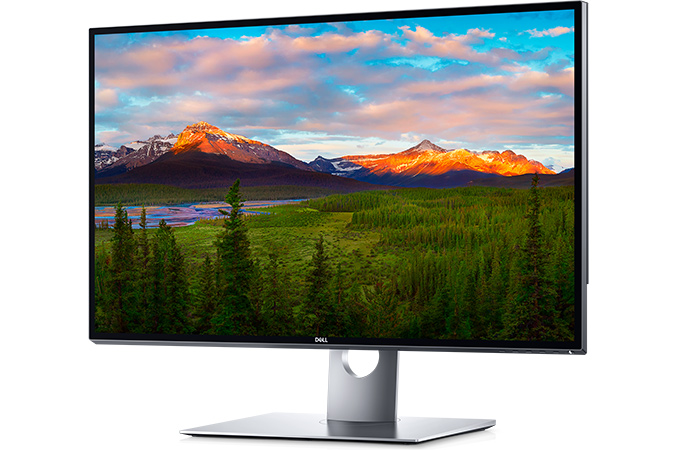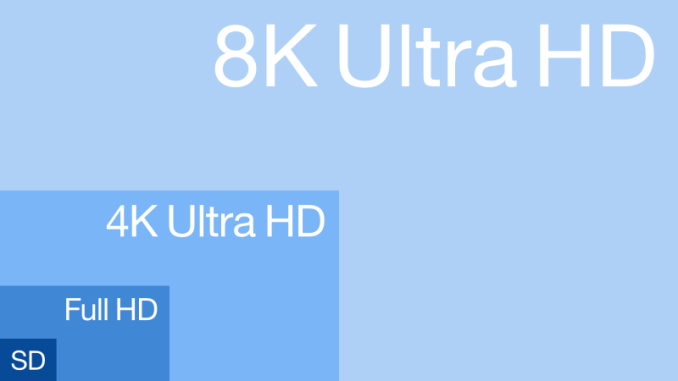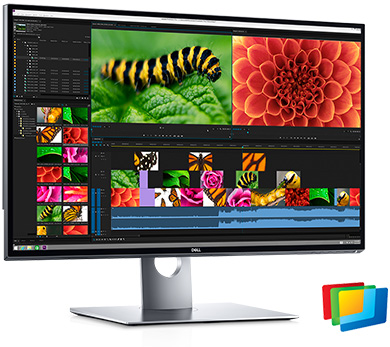Dell’s 32-inch 8K UP3218K Display Now For Sale: Check Your Wallet
by Ian Cutress on March 24, 2017 7:55 AM EST
Back at CES in January, Dell announced the next step in personal screen resolution advancements. The recent rise of ‘4K’ (or more accurately, Ultra-HD at 3840x2160) monitors has shown that there is a demand for high resolution interfaces beyond a smartphone. Back when UHD monitors in a 16:9 format launched en masse, prices were high ($3500-5000+) and stocks were limited – I remember back in 2013 testing the Sharp 32-inch 4K display at a vendor in Taiwan several years ago in one of the first pieces to test 4K/UHD gaming. The fact that this was the only UHD monitor that GIGABYTE had in their HQ was a testament to how new the technology was. Now, 24-inch UHD displays can be had for as little as $350. We may see history repeat itself with 8K monitors from today.
As always, the first Dell monitors off the production line are designed to be high-end professional monitors. The UP3218K goes in at higher than average specifications, such as 1300:1 contrast ratio, 400 nits brightness, but also offers 100% AdobeRGB, 100% RGB and 98% DCI-P3. The UP3218K is part of Dell’s UltraSharp range, which means we should expect the monitor to be color calibrated out of the box to within a given dE value, typically dE < 3.
| Specifications Dell UltraSharp UP3218K |
||
| Panel | 31.5" IPS | |
| Resolution | 7680 × 4320 | |
| Brightness | 400 cd/m² | |
| Contrast Ratio | 1300:1 | |
| Refresh Rate | 60 Hz | |
| Viewing Angles | 178°/178° horizontal/vertical | |
| Color Saturation | 100% Adobe RGB 100% sRGB 98% DCI-P3 100% Rec 709 |
|
| Display Colors | 1.07 billion | |
| Inputs | 2 × DisplayPort 1.4 | |
| Connectivity | USB 3.0 Hub: 3x USB 3.0-A Downstream 1x USB 3.0-A Downstream (power) USB 3.0-B Upstream Audio Line-Out |
|
| Rated Power Consumption | 87 W | |
Naturally a question pops up as to how to hook an 8K display up, especially will all the bells and whistles. The display uses two DP1.4 inputs to provide enough bandwidth, which means that we’re typically dealing with the internal controller stitching together two 3840x4320 displays, similar to how the early 4K monitors did (but with a few more years experience on how to do it). It is possible that Dell supports a single DP1.4 cable, which would most likely use Display Stream Compression 1.2 to offer a visually lossless image as a single panel, however one may suspect that given the target market for this panel, a truly lossless image is probably preferred, even when dealing with two input streams.
Overall an 8K monitor offers 33.2 megapixels of coverage, which in a 32-inch (31.5-inch) form factor gives 280 pixels per inch. 33.2 megapixels is four times that of UHD, which is 8.3 megapixels. Users wanting to play some AAA titles at 8K on this beast are going to run into walls with memory bandwidth very quickly, however eSports titles should run OK. Using some undocumented tricks, a pair of tests in our new set of gaming benchmarks for CPU reviews can render at 8K or even 16K without needing a monitor, so you might see some numbers in due course showing where we stand with GPU power on this technology. It’s worth noting that Raja Koduri, SVP of AMD’s Radeon Technology Group, has stated that VR needs 16K per-eye at 144 Hz to emulate the human experience, so we're still a way off in the display technology reaching consumer price points at least.
From 2013 to 2016, the prices of UHD monitors fell from $3500-$5000 to $350-$500. Extrapolating this, users wanting an 8K panel on their desk in a more comfortable price bracket might have to wait until 2020 or so to get one. By then, 16K might exist, back at the $5000 price point. Maybe.
Dell’s UP3218K is now available to purchase on Dell’s website for $4999. Currently taking pre-orders, the estimated shipping date is set as April 17th for US50. Linus from LinusTechTips should be happy, as they just invested in a pair of 8K video cameras. Time to submit my own acquisition request…

Image from Wikipedia
Source: Dell













94 Comments
View All Comments
A5 - Friday, March 24, 2017 - link
Should be affordable by the time my 1440p monitor dies. And maybe Windows programs will have competent HiDPI support by then, too...I assume by then there will be bigger, better DisplayPort standards to make it single-cable, too.
TristanSDX - Friday, March 24, 2017 - link
Price is artifically pumped. Production costs are below 1000$, or even less. 300-400 DPI is none technical challenge.r3loaded - Friday, March 24, 2017 - link
At a high DPI like this on a large panel, yields become an issue. Unless of course you want to use one of the faulty panels that either don't work or have tons of dead pixels.Spunjji - Friday, March 24, 2017 - link
Said with the confidence of someone who has no idea what manufacturing tolerances and panel failure rates are like for a panel of that size.BedfordTim - Friday, March 24, 2017 - link
Nothing costs anywhere near its manufacturing cost.Think about packaging, shipping, duty, R&D, marketing, distribution costs etc.
BrokenCrayons - Friday, March 24, 2017 - link
Wow, that power consumption is crazy! I could feed two laptops running a full load for the power that screen alone requires. I hope we figure out how to make these things more efficient because newer flat panels are actually overtaking the power needed to drive old CRT screens.Death666Angel - Friday, March 24, 2017 - link
A quick google search shows a TomsHardware article from 2010 which has 19" CRTs in the region of 100W @ 50% brightness and only slightly below that (91 - 99W) @ 10% brightness.Seems like 87W (which is likely less when calibrated to 140cd/m²) for a 32" 8k display is perfectly fine compared to CRTs.
BrokenCrayons - Friday, March 24, 2017 - link
That's pretty much what I'm getting at since a 14-15 inch monitor from 2000-ish would be quite a bit lower than 100W. Since flat panel displays were initally sold as lower power consumption alternatives, it seems like we're taking huge strides backwards.DanNeely - Friday, March 24, 2017 - link
A 21" CRT from the same time would be around or a bit above 100W. And a current 22" LCD is a lot lower than 100W. At similar market segments the power draws are roughly comparable with the I'm rich screens slotting in around 100W and more affordable/mass market ones falling to lower power levels.Death666Angel - Friday, March 24, 2017 - link
Wait, why are you comparing extremly dissimilar products? I hate car comparisons, but you wouldn't compare a Smart to a truck, right? Flat panel monitors were positioned as smaller alternatives to CRTs that did not have the issue of flickering images on steady backgrounds (much easier on the eyes for productivity work like spreadsheets and word documents). They offered lower power consumption when comparing apples to apples (similar sizes, similar performance). I don't get why you insist on comparing 15" tech from 2000 to 32" tech from 2017.